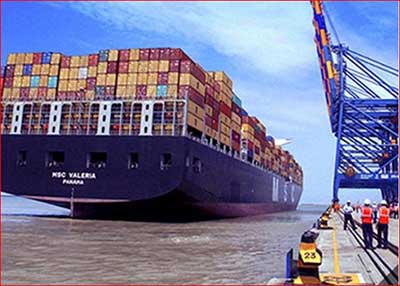Relevance: GS-3: Indian Economy and issues relating to planning, mobilization, of resources, growth, development, and employment.
Key Phrases: Trade Promotion Bodies, Exporters Organization, World Trade Organization, European Union, FTA, Export Development Authorities, ITPO, Ministry of Commerce and Industry.
Context:
- The government is of the view that the momentum of India’s merchandise exports needs to be sustained to achieve the ambitious export target of $1 trillion by 2030.
Current Status:
- India’s merchandise exports have been remarkable in 2021-22 achieving the target of $400 billion well before the end of the financial year.
- Exports have increased from $290 billion in 2020-21 to $419 billion in 2021-22 reflecting an increase of more than 40 percent on an annual basis.
- In order to achieve this, the government has recalibrated its FTA strategy and has signed trade pacts with the United Arab Emirates (UAE) and Australia.
- It is also negotiating FTAs with the UK, Israel, Canada, and the European Union.

What are Major Road Blocks?
- Outdated Trade Promotion Bodies:
- India has set up 37 trade promotion bodies, known as Export Promotion Councils, Commodity Boards, Export Development Authorities, and Federation of India’s Exporters Organization.
- Majority of these bodies were set up in the period 1960-80 and many of them have outlived their relevance with India’s changing export basket.
- Power of States:
- As a federal system, much power and decision-making are decentralized in India, with differences at the state level in political leadership, quality of governance, regulations, taxation, and labor relations.
- Infrastructure:
- India’s congested road transportation infrastructure, delays in railway freight movement, inefficient and long turnaround time at ports, and fast-growing but highly concentrated airport sector all contribute to significant capacity constraints.
- High Tariffs and Protectionist Policies
- India has the highest average applied tariff of any G20 country and some of the highest bound tariff rates among World Trade Organization members.
Do you know?
- The World Trade Report (WTR) is the annual report published since 2003 by the World Trade Organization.
- India Trade Promotion Organisation (ITPO), headquartered at Pragati Maidan, is the nodal agency of the Government of India under aegis of the Ministry of Commerce and Industry (India) for promoting the country's external trade.
Key Institutional Reforms That are Critical to Revitalise Domestic Trade Institutions
- Deeper Insights Into Trade Related Issues:
- In a value-chain-driven globalized set-up, there is a need to develop deeper insights into trade-related issues not from a perspective of the industry but at a firm and product level, thus demanding the revamping of trade promotion bodies.
- Transparency and Accountability:
- There is a need to bring transparency and accountability to the merit-based, rule-based and result-oriented system.
- Role of trade promotion bodies:
- The role of trade promotion bodies (EPCs/Boards, etc) should not be limited to product-mandate but to ensure research-supported and competition-based advisory and facilitative role to strengthen India’s external trade regime, business ecosystem, and export ecosystem.
- This will ensure the global competitiveness of Indian products
in international markets. Further, trade promotion bodies should not act
in a silo but
- as a consortium of creating a business ecosystem for start-ups,
- new exporters through skills development,
- product and market identification,
- hand-holding and advisory services, buyer-seller meets,
- participation in market access initiatives including trade fairs,
- Universal Application Programming Interface:
- Universal Application Programming Interface (API) platform can offer the harmonised set of programming instructions to all 63 (Partner Government Agencies) PGAs under standardised web-based software applications to communicate with each other.
- The API-enabled PGA platform will reduce the time in communication between Indian Customs and PGAs and help them interact effectively thus transforming the exim compliance eco-system of India.
- This will bring efficiency and transparency in regulatory clearances both at the time of export or imports and also for registration and audit compliances.
- States’ Role:
- With ever-increasing external engagements and a target to achieve $1 trillion of exports, it is the high time to frame clear, definable, and ambitious mandates for the State-level trade promotion bodies.
- For India to emerge as a champion of exports, the State level bodies should be empowered, envisioned, and enthused with business targets in the area of their product or service strengths.
- The State level trade institutions can play a vital role in not only resolving State level infrastructural problems (State and local roads, pollution, land, power stabilisation, water treatment, sewerage, etc) but also the associated administrative challenges.
Conclusion:
- A stable and sustained increase in India’s export requires next-generation reforms in its domestic trade institutions which act as catalysts to the growth of exports. These reforms should adopt a holistic approach rather than piecemeal progress.
- Hopefully, the new foreign trade policy takes a cognisance of the aforementioned domestic institutional reforms.
Source: The Hindu BL
Mains Question:
Q. Briefly discuss the steps government should take to achieve the ambitious export target of $1 trillion by 2030. (250 words).








